RBSE Solutions for Class 6 Maths Chapter 1 Knowing our Numbers InText Questions
Rajasthan Board RBSE Solutions for Class 6 Maths Chapter 1 Knowing our Numbers InText Questions Textbook Exercise Questions and Answers.
Rajasthan Board RBSE Solutions for Class 6 Maths in Hindi Medium & English Medium are part of RBSE Solutions for Class 6. Students can also read RBSE Class 6 Maths Important Questions for exam preparation. Students can also go through RBSE Class 6 Maths Notes to understand and remember the concepts easily. Students are advised to practice अनुपात और समानुपात के प्रश्न class 6 of the textbook questions.
RBSE Class 6 Maths Solutions Chapter 1 Knowing our Numbers InText Questions
(Try These Page No: 2)
Question 1.
Can you instantly find the greatest and the smallest numbers in each row?
1. 382, 4972, 18, 59785, 750
2. 1473, 89423, 100, 5000, 310
3. 1834, 75284, 111, 2333, 450
4. 2853, 7691, 9999, 12002, 124
What that easy ? Why was it easy ?
Answer:
1. 59785 is the greatest and 18 is the smallest.
2. 89423 is the greatest and 100 is the smallest.
3. 75284 is the greatest and 111 is the smallest.
4.12002 is the greatest and 124 is the smallest.
Yes, it was easy to identify the greatest or the smallest number in a row because a numeral containing more digits is greater.

Question 2
Find the greatest and the smallest numbers:
(a) 4536,4892,4370,4452
(b) 15623,15073,15189,15800
(c) 25286,25245,25270,25210
(d) 6895,23787,24569,24659
Make five more problems of this kind and give to your friends to solve.
Answer:
(a) 4892 is the greatest and 4370 is the smallest.
(b) 15800 is the greatest and 15073 is the smallest.
(c) 25286 is the greatest and 25210 is the smallest.
(d) 24659 is the greatest and 6895 is the smallest.
Five more problems of this kind are given below:
Find the greatest and smallest numbers.
1. 8647, 8903, 8481, 8563
Answer:
8903 is the greatest and 8481 is the smallest.
2. 16734, 16184, 16290, 16811
Answer:
16811 is the greatest and 16184 is the smallest.

3. 26397, 26356, 26381, 26321
Answer:
26397 is the greatest and 26321 is the smallest.
4. 7896, 24898, 25670, 25960
Answer:
25960 is the greatest and 7896 is the smallest.
5. 7542, 7549, 7547, 7545
Answer:
7549 is the greatest and 7542 is the smallest.
(Try These Page 3, 4)
Question 1.
Use the given digits without repetition and make the greatest and smallest 4-digit numbers.
(a) 2, 8, 7,4
(b) 9, 7, 4, 1
(c) 4, 7, 5, 0
(d) 1, 7, 6, 2
(e) 5, 4, 0, 3.
(Hint: 0754 is a 3-digit number.)
Answer:
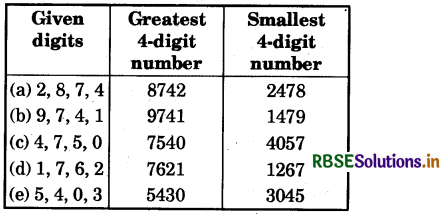

Question 2.
Now make the greatest and the smallest 4-digit numbers by using any one digit twice:
(a) 3, 8, 7
(b) 9, 0, 5
(c) 0,4, 9
(d) 8, 5, 1
(Hint: Think in each case which digit will you use twice.)
Answer:
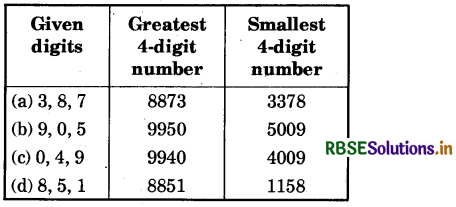
Note: In the greatest number, the greatest digit is used twice while in the smaller number, the smallest digit is used twice.

Question 3.
Make the greatest and the smallest 4-digit numbers using any four different digits with condition as given.
Answer:
|
(a) Digit 7 is always at ones place |
Greatest 9867 |
|
(b) Digit 4 is always at tens place |
Greatest 9847 |
|
(c) Digit 9 is always at hundreds place |
Greatest 8976 |
|
(d) Digit 1 is always at thousands place |
Greatest 1987 |
Question 4.
Take two digits, say 2 and 3. Make 4-digit numbers using both the digits equal number of times.
(i) Which is the greatest number?
Answer:
3322.
(ii) Which is the smallest number?
Answer:
2233.

(iii) How many different number can you make in all?
Answer:
3322, 2233, 3232, 2323, 2332, 3223,
i.e.
We can make 6 different numbers in all.
(Review Exercise Page No:4)
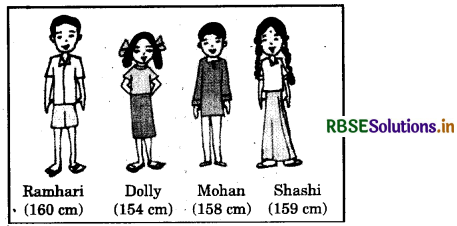
Question 1.
Who is the tallest?
Answer:
Ramhari (160 cm) is the tallest.
Question 2.
Who is the shortest?
Answer:
Dolly (154 cm) is the shortest.

(a) Can you arrange them in the increasing order of their heights?
Answer:
Dolly (154 pm) < Mohan (158 cm) < Shashi (159 cm) < Ramhari (160 cm).
(b) Can you arrange them in the decreasing order of their heights?
Answer:
Ramhari (160 cm) > Shashi (159 cm) > Mohan (158 cm) > Dolly (154 cm).
Question 3.
Which to buy?
Sohan and Rita went to buy an almirah. There were many almirahs available with their price tags.

(a) Can you arrange their prices in increasing order?
Answer:
₹ 1788 < ₹ 1897 < ₹ 2635 < ₹ 2854 < ₹ 3975
(b) Can you arrange their prices in decreasing order?
Answer:
₹ 3975 < ₹ 2854 < ₹ 2635 < ₹ 1897 < ₹ 11788
(Try These Page No:4)
Question 1.
Think of five more situations where you compare three or more quantities.
Answer:
- The annual income of 4 employees; Ajay, Aman, Ramesh, Mahesh are.
₹ 5,00,000, ₹ 17,25,000, ₹ 2,50,000, ₹ 4,00,000 respectively. - The number of students in 4 colleges; A, B, C, D are 1650, 1980, 5790, 2290 respectively.
- The heights of five boys; Hridaya, Anand, Apoorva, Ansh and Harsha are 160 cm, 190 cm, 145 cm, 182 cm, 172 cm respectively.
- The weight of 4 students; Neha, Sneha, Riya, Kashvi are 45 kg, 52 kg, 62 kg, 59 kg respectively.
- The distance of 4 cities from the capital city New Delhi are:
City A-522 km, City B-A85 km, City C-395 km, City D-905 km.

(Try These Page No: 5)
Question 1.
Arrange the following numbers in ascending order:
(a) 847, 9754, 8320, 571
(b) 9801,25751,36501,38802
Answer:
(a) 571,847, 8320, 9754
(b) 9801, 25751, 36501, 38802
Question 2.
Arrange the following numbers in descending order:
(a) 5000, 7500, 85400, 7861
(b) 1971, 45321, 88715, 92547
Answer:
(a) 85400, 7861, 7500, 5000
(b) 92547, 88715, 45321, 1971
Question 3.
Make ten such examples of ascending/descending order and solve them.
Answer:
Ten such examples of ascending/ descending order are as follows :
(a) The numbers arranged in ascending order:
1. 5439, 2349, 5895, 3790
2. 25547, 32948, 851, 4490
3. 8549, 7640, 11123, 15490
4. 45370, 45270, 45570, 45705
5. 32754, 32954, 32118, 32798
(b) The numbers arranged in descending order:
6. 8546, 9549, 9547, 9540
7. 18254, 16554, 16725, 16245
8. 43934, 63953, 53967, 63998
9. 24532, 14546, 14570, 34595
10. 78551, 78249, 72545, 84847
Solution of Examples:
(a) The numbers arranged in ascending order are as follows :
1. 2349, 3790, 5439, 5895
2. 851, 4490, 25547, 32948
3. 7640, 8549, 11123, 15490
4. 45270, 45370, 45570, 45705
5. 32118, 32754,32798, 32954
(b) The numbers arranged in descending order are as follows :
6. 9549, 9547, 9540, 8546
7. 18254, 16725, 16554, 16245
8. 63998, 63953, 53967, 43934
9. 34595, 24532, 14570, 14546
10. 84847, 78551, 78249, 72545

(Try These Page No:6)
Question 1.
Read and expand the numbers wherever there are blanks:
Answer:
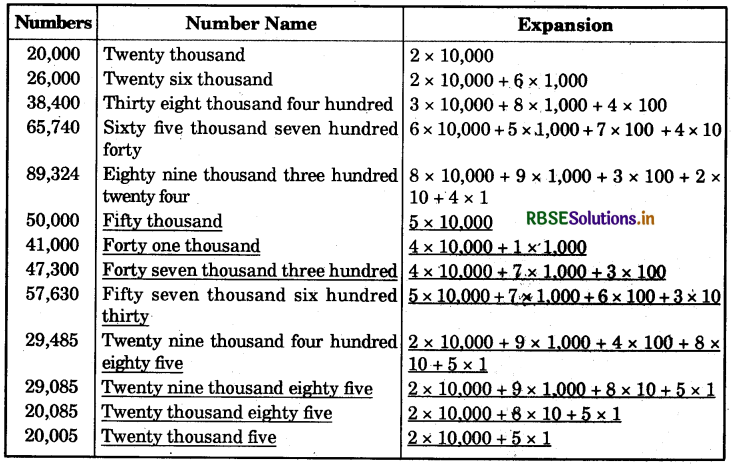
Question 2.
Write five more 5-digit numbers, read them and expand them.
Answer:

(Try These Page No: 7)
Question 1.
Read and expand the numbers wherever there are blanks.
Answer:
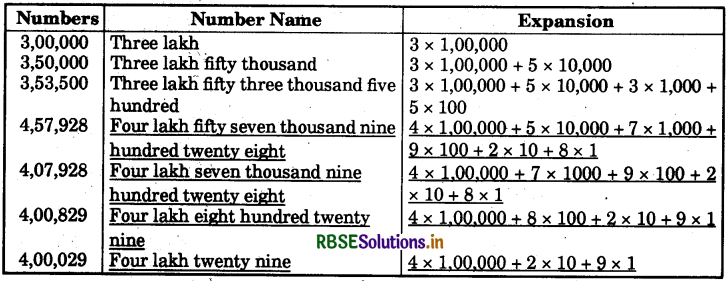

(Try These Page No: 8)
Question 1.
What is 10 - 1 = ?
Answer:
10 - 1 = 9
Question 2.
What is 100 - 1 = ?
Answer:
100 - 1 = 99
Question 3.
What is 10,000 - 1 = ?
Answer:
10,000 - 1 = 9,999
Question 4.
What is 1,00,000 -1 = ?
Answer:
1,00,000 - 1 = 99;999
Question 5.
What is 1,00,00,000 -1 = ?
Answer:
1,00,00,000 - 1 = 99,99,999
[Hint: Use the said pattern.]

(Try These Page No: 8)
Question 1.
Give five examples where the number of things counted would be more than 6-digit number.
Answer:
(a) Number of account holders in nationalised banks in India.
(b) Number of railway tickets issued in .a decade in India.
(c) Number of hair strands on human head.
(d) Number of people in India.
(e) Number of rice grains in one sack of rice.
Question 2.
Starting from the greatest 6-digit number write the previous five numbers in descending order.
Answer:
The largest six digit number is 9,99,999. The. previous five numbers in descending order are:
9,99,998 > 9,99,997 > 9,99,996 > 9,99,995 > 9,99,994
Question 3.
Starting from the smallest 8-digit number, write the next five numbers in ascending order and read them.
Answer:
The smallest 8-digit number is 1,00,00,000.
The next five numbers in ascending order are:
1,00,00, 001 One crore one
1,00,00, 002 One crore two
1, 00, 00, 003 One crore three
1, 00, 00, 004 One crore one
1, 00, 00, 005 One crore one
(Try These Page No: 11)
Question 1.
Read these numbers. Write them using placement boxes and then write their expanded form.
(i) 475320
(ii) 9847215
(iii) 97645310
(iv) 30458094
Answer:

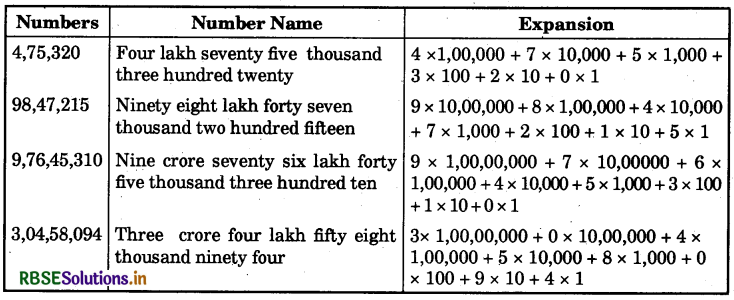
(a) Which is the smallest number?
Answer:
The smallest number is 475320.
(b) Which is the greatest number?
Answer:
The greatest number is 97645310.
(c) Arrange these numbers in ascending and descending orders.
Answer:
The numbers arranged in ascending order are as follows:
475620, 9847215, 30458094,97645310
The number arranged in descending order are as follows :
97645310, 30458094, 9847215, 475320

Question 2.
Read these numbers :
(i) 527864
(ii) 95432
(iii) 18950049
(iv) 70002509
(a) Write these numbers using placement boxes and then using commas in Indian as well as International system of numeration.
Answer:
Using placement boxes:
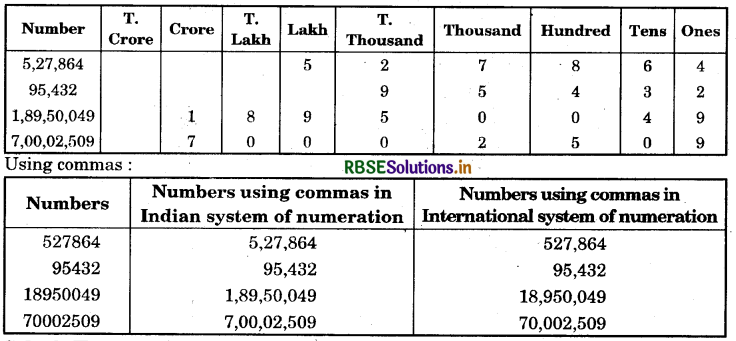
(b) Arrange these in ascending and descending order.
Answer:
The number arranged in ascending order are as follows :
95432, 527864, 18950049, 70002509
The number arranged in descending order are as follows :
70002509, 18950049, 527864, 95432

Question 3.
Take three more groups of large numbers and do the exercise given above.
Answer:
The three more groups of large numbers are as follows :
(i) 50000, 500000, 5000000
(ii) 623623, 6023623, 60023623
(iii) 7865432, 7865342, 78653421
Using placement box:

Using commas:
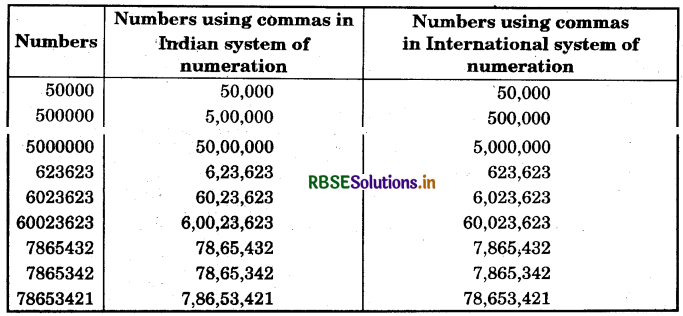
Arranged these in ascending order:
Answer:
(i) 50,000; 5,00,000; 50,00, 000
(ii) 6,23,623; 60,23,623; 6,00,23,623
(iii) 78,65,342; 78,65,432; 7,86,53,421
Arranged these in descending order:
Answer:
(i) 50,00,000; 5,00,000; 50,000
(ii) 6,00,23,623; 60,23,623; 6,23,623
(iii) 7,86,53,421; 78,65,432; 78,65,342

(Try These page No: 11)
Question 1.
You have the following digits 4, 5, 6, 0, 7 and 8. Using them, make five numbers each with 6 digits:
(a) Put commas for easy reading.
(b) Arrange them in ascending and descending order.
Answer:
(a) Five numbers are :
4,05,678
5,40,867
6,54,780
8,76,504
7,68,045
(b) Ascending order:
4,05,678
5,40,867
6,54,780
7,68,045
8,76,504
Descending order:
8,76,504
7,68,045
6,54,780
5,40,876
4,05,678

Question 2.
Take the digits 4, 5, 6, 7, 8 and 9. Make any three numbers each with 8 digits. Put commas for easy reading.
Answer:
(i) 9,99,87,654
(ii) 4,56,78,999
(iii) 4,78,56,999
Question 3.
From the digits 3, 0 and 4, make five numbers each with 6 digits use commas.
Answer:
(i) 3,04,304
(ii) 3,44,300
(iii) 4,30,043
(iv) 4,43,434
(v) 4,04,043
(Try These Page 12)
Question 1.
How many centimetres make a kilometre?
Answer:
1 km = 1000 m and 1 m = 100 cm
∴ 1000 m = 100 × 1000 cm = 1,00,000 cm
Question 2.
Name five large cities in.India. Find their population. Also, find the distance in kilometer between each pair of these cities.
Answer:
Following are the five large cities of India along with their population :
1. Mumbai - 12,442,373 - 1,24,42,373
2. Delhi - 11,034,555 - 1,10,34,555
3. Bangalore - 8,443,675 - 84,43,675
4. Hyderabad - 6,731,790 - 67,31,790
5. Ahmedabad - 5,577,940 - 55,77,940

(Try These Page No: 13)
Question 1.
How many milligrams make one kilogram?
Answer:
1 kilogram = 1000 gram
and 1 gram = 1000 mg
100 gm = 100 × 1000 mg
1 kg = 10,00,000 mg
Question 2.
A box contains 2,00,000 medicine tablets each weighing 20 mg. What is the total weight of all the tablets in the box in gram and in kilogram?
Answer:
No. of tablets = 2,00,000
Weight of 1 tablet = 20 mg
Total weight of 2,00,000 tablets
= 2,00,000 × 20 mg
= 40,00,000 mg
∵ 1 mg = 1000 gm
∴ 40,00,000 mg = 40,00,000/1000 gm
= 4000 gm
∵ 1 kg = 1000 gm
∴ 4000 gm = 4000/1000 = 4 kg

(Try These Page No:13-14)
Question 1.
A bus started its journey and reached different places with a speed of 60 km/hour. The journey is shown below:
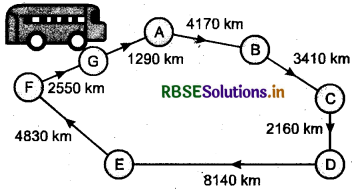
(i) Find the total distance covered by the bus from A to D. .
Answer:
Distance from A to D
= AB + BC + CD
= 4170 + 3410 + 2160
= 9740 km
(ii) Find the total distance covered by the bus from D to G.
Answer:
Distance from D to G
= DE + EF + FG = 8140 + 4830 + 2550
= 15520 km
(iii) Find the total distance covered by the bus, if it starts from A and returns back to A,
Answer:
Distance starting from A returns back to A
= AB + BC + CD + DE + EF + FG + GA
= 4170 + 3410 + 2160 + 8140 + 4830 + 2550 +1290
= 26550 km

(iv) Can you find the difference of distances from C to D and D to El
Answer:
Difference of distances from C to D and D to E
= DE - CD = 8140 - 2160 = 5980 km
(v) Find out the time taken by the bus to reach:
(a) A to B,
(b) C to D,
(c) E to G,
(d) Total journey.
Answer:
Time taken by bus to reach:
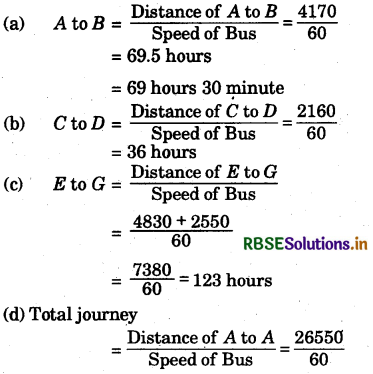
= 442.5 hours
= 442 hours 30 minute.

Question 2.
Raman’s shop:
|
Things |
Price |
|
Apples |
₹ 40 per kg |
|
Oranges |
₹ 30 per kg |
|
Combs |
₹ 3 for one |
|
Toothbrushes |
₹ 10 for one |
|
Pencils |
₹ 1 for one |
|
Notebooks |
₹ 6 for one |
|
Soap cakes |
₹8 for one |
The sales during the last year:
|
Apples |
2457 kg |
|
Oranges |
3004 kg |
|
Combs |
22760 |
|
Toothbrushes |
25367 |
|
Pencils |
38530 |
|
Notebooks |
40002 |
|
Soap cakes |
20005 |
(a) Can you find the total weight of apples and oranges Raman sold last year?
Answer:
Weight of apples = 2457 kg
Weight of oranges = 3004 kg
Toted weight = 2457 kg + 3004 kg = 5,461 kg
The total weight of oranges and apples = 5,461 kg.
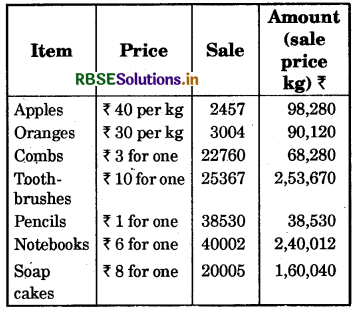

(b) Can you find the total money Raman got by selling apples?
Answer:
1 kg = ₹ 40
2457 kg = ₹ 40 × 2457
= ₹ 913,280
Raman got highest amount by selling toothbrushes.
(c) Can you find the total money Raman got by selling apples and oranges together?
Answer:
Total money Raman got by selling apples and oranges
= Cost of 2457 kg apples + cost of 3004 kg oranges
= ₹ 40 × 2457 + ₹ 30 × 3004
= ₹ 98,280 + ₹ 90,120 = ₹ 1,88,400
(d) Make a table showing how much money Raman received from selling each item. Arrange the entries of amount of money received in descending order. Find the item which brought him the highest amount. How much is this amount?
Answer:
Arranging in descending order: 2,53,670; 2,40,012; 1,60,040; 98,280; 90,120; 68,280; 38,530
(Try These Page No:19)
Question 1.
Round these numbers to the nearest tens:
28, 32, 52, 41, 39, 48, 64, 59, 99, 215, 1453, 2936
Answer:

(Try These Page No: 20)
Question 1.
Round off the given numbers to the nearest tens, hundreds and thousands:
Given Number-Approximate to Nearest-Rounded Form
|
75847 |
Tens |
.................... |
|
75847 |
Hundred |
.................... |
|
75847 |
Thousand |
.................... |
|
75847 |
Ten thousand |
.................... |
Answer:
|
75847 |
Tens |
75850 |
|
75847 |
Hundred |
75800 |
|
75847 |
Thousand |
76000 |
|
75847 |
Ten thousand |
80000 |

(Try These Page No: 22)
Question 1.
Estimate the following products :
(a) 87 × 313
(b) 9 × 795
(c) 898 × 785
(d) 958 × 387
Answer:
(a) 87 × 313 → 90 × 300 = 27000
(b) 9 × 795 → 10 × 800 = 8000
(c) 898 × 785 → 900 × 800 = 720000
(d) 958 × 387 → 1000 × 400 = 400000
Question 2.
Make five more such problems and solve them.
Answer:
5 more examples :
(i) 8 × 189 → 10 × 200 = 2000
(ii) 42 × 75 → 40 × 80 = 3200
(iii) 21 × 47 → 20 × 50 = 1000
(iv) 119 × 8 → 100 × 10 = 1000
(v) 63 × 897 → 60 × 900 = 54000
(Try These Page No: 23)
Question 1.
Write the expressions for each of the following using brackets :
(a) Four multiplied by the sum of nine and two.
Answer:
4 × (9 ÷ 2)
(b) Divide the difference of eighteen and six by four.
Answer:
(18 - 6) ÷ 4
(c) Forty five divided by three times the sum of three and two.
Answer:
45 ÷ {(3 + 2) × 3}
Question 2.
Write three different situations for (5 + 8) × 6.
(One such situation is: Sohani and Reeta work for 6 days; Sohani works 5 hours a day and Reeta 8 hours a day. How many .hours do both of them work in a week?)
Answer:
3 situations for (5 + 8) × 6 :
- Ajay and Aman eats 5 and 8 chocolates respectively; How many chocolates do they eat together in a week except Sunday.
- Ramesh and Suresh buys 5 and 8 balls respectively. If the cost of each ball is ₹ 6. How much money do they spent together on balls?
- Riya and Shreya got 5 and 8 notebooks respectively and cost of each notebook is ₹ 6. How much money do they spent together on buying notebooks?

Question 3.
Write five situations for the following where brackets would be necessary:
(a) 7(8 - 3)
(b) (7 + 2) (10 - 3)
Answer:
(a) 7(8 - 3)
- Seven times the difference of eight and three.
- Ram works 8 hours daily but he remains absent for 3 hours daily. How many hours in all did he work?
- Each of seven buckets take 8 litre of water. 3 litre of water flows out of each bucket. Now how much water is there in all buckets?
- Seven children with ₹ 8 each went to, market. Each of them bought pens costing ₹ 3. What the total money left with them in all?
- Ramesh takes ₹ 8 from his father daily and makes an expenditure of₹ 3 daily. How much money will he be able to collect in a week?
(b) (7 + 2) (10 - 3)
- Total of 7 times and 2 times of difference of 10 and 3.
- Mani takes ₹ 10 from his father daily and makes an expenditure of ₹ 3 daily. How much money will he be able to collect in first seven days and next two days of ihe month?
- Ram and Shyam are twp real brothers. They take 10 toffees from their father daily and eat 3 toffees daily. How many toffees were saved by Ram in 7 days and by Shyam in 2 days?
- A restaurant serves tiffin-lunch for 7 adults and 2 children in each of 10 houses of a society. On a Sunday, 3 houses were locked. How many persons were served lunch on that Sunday ?
- 7 persons hired a van upto railway station for ₹ 10 per head. The van driver, added 2 more passengers and reduced the fare by ₹ 3 per head. What was the driver's total collection as fare?
(Try These Page No: 25)
Question 1.
Write in Roman Numerals:
(1) 73
Answer:
73 = LXXIII

(2) 92
Answer:
92 = XCII

- RBSE Solutions for Class 6 Maths Chapter 2 Whole Numbers InText Questions
- RBSE Class 6 Maths Important Questions Chapter 1 अपनी संख्याओं की जानकारी
- RBSE Solutions for Class 6 Maths Chapter 7 भिन्न Intext Questions
- RBSE Solutions for Class 6 Maths Chapter 7 Fractions Ex 7.4
- RBSE Solutions for Class 6 Maths Chapter 1 Knowing our Numbers Ex 1.1
- RBSE Solutions for Class 6 Maths in Hindi Medium & English Medium
- RBSE Solutions for Class 6 Maths Chapter 7 Fractions InText Questions
- RBSE Solutions for Class 6 Maths Chapter 7 Fractions Ex 7.6
- RBSE Solutions for Class 6 Maths Chapter 7 Fractions Ex 7.5
- RBSE Solutions for Class 6 Maths Chapter 7 Fractions Ex 7.3
- RBSE Solutions for Class 6 Maths Chapter 4 Basic Geometrical Ideas InText Questions